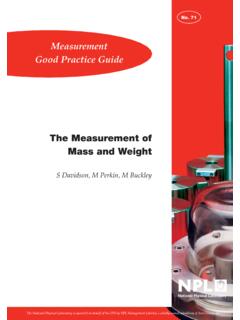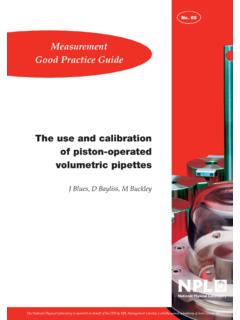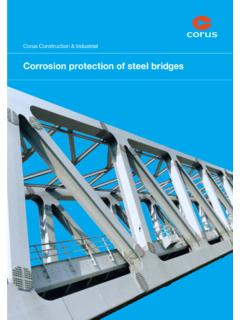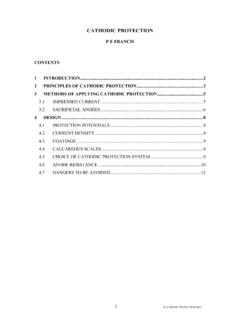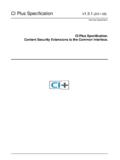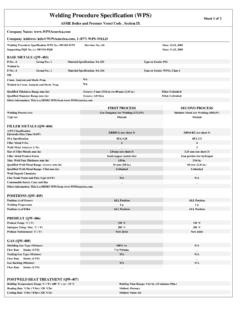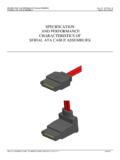Transcription of 3 Specification of Parameters - National Physical …
1 3 specification of parameters It is well known that the definitions of Parameters should be unambiguous to avoid being open to different interpretations by both users and metrology software developers. What is not so well known is that Parameters should also have stable or robust definitions in order that they reflect genuine properties of a surface. Here a parameter definition is considered mathematically stable if a small change in the profile implies a small change in the parameter value. Unfortunately the parameter definitions given in ISO 4287 1997[4] (and ISO 4288 - 1996)[5] are not always unambiguous or stable. Since these Specification standards were first drafted, much knowledge has been gained into unambiguous and stable definitions of surface texture Parameters .
2 This new knowledge has been used in the present project to re-evaluate the parameter definitions and produce unambiguous stable definitions that are consistent (where possible) with those in the international standards. The basic framework of the softgauges developed within the project is shown in figure Softgauge Basic Framework ISO 4287-1997 (ISO 4288-1996) SOFTGAUGE POINTS ASSUME: Ls Filtered Equally spaced No Form FILTRATION Gaussian Filter (ISO 11056) R W P Lc High pass Lc Low pass No Filter FIELD Parameters FEATURE Parameters Amplitude Other Peak/Valley Spacing Ra, Rq, Rsk,Rku, Rp, Rv.
3 Rz Rt Rc RSm Feature Type1 Points Points Local Peak/Valley Crossovers Segmentation2 Cut-off Evaluation Based on feature Based on feature Combination3 None None Remove insignificant features Remove insignificant features Attributes Cut-off Evaluation Significant features Significant features Statistics Mean/Max Value Mean/Max Mean/Max Notes 1. Feature type is the basic element from which subsequent calculations are determined. 2. Segmentation is used to determine the initial portions of the profile. 3. Combination removes insignificant segments to leave significant segments.
4 This removes artificially small segments due to noise, etc. making the measurand stable. Figure Softgauge basic framework Gaussian Filter The Gaussian filter is currently the only standardised surface texture filter (ISO 11562 1996)[6]. This standard defines the long wave (low pass) Gaussian filter as a continuous weighted convolution for an open profile, with the weights taking the classic Gaussian bell shape and a cut-off wavelength value of 50 % transmission. The short wave (high pass) Gaussian filter is defined as the difference between the surface profile and the long wave profile component resulting from the long wave Gaussian filter with the same 50 % cut-off wavelength. ISO 11562-1996[6] does not give any information on implementation (algorithms, implementation problems, etc.) of the Gaussian filter.
5 There are no tolerance values given within this standard. Instead of tolerances, a graphical representation of the deviations of the realised Gaussian filter from the defined Gaussian filter shall be given as a percentage value over the wavelength range to 100 cut-offs. In practice, measured surface texture data is not continuous but takes discrete values. In some very special cases it may be possible to reconstruct the continuous profile from these discrete points using a kernel function and thus implement the Gaussian filter directly as a continuous weighted convolution. In this project, it is assumed that this is not the case and a discrete approximation to the definition given in ISO 11562 1996[6] will be used. Further, it will also be assumed that the data points are equally spaced along the X-axis.
6 There are principally two equally valid approaches to implementing a discrete approximation to the long wave Gaussian filter: 1. Via a discrete weighted convolution in the spatial domain. 2. Via a transformation to the Fourier domain, applying a transmission weighting to the individual wavelengths and transforming back to the spatial domain. The first approach is implemented here since it is less complicated to implement with differing numbers of points in the profile. An outline algorithm can be found in Krystek 2004[7] (Algorithm 1). The short wave Gaussian filter can be implemented as the difference between the surface profile and the long wave profile component resulting from the long wave Gaussian filter with the same 50 % cut-off wavelength. Other considerations in a discrete implementation are distortion effects due to: The ends of the profile: To minimise this distortion a portion of the profile at the beginning (run-up) and at the end (run-down) of the profile is removed.
7 It is recommended that one cut-off at each end of the profile be removed. The finite length of the profile: To minimise this distortion there should be a minimum number of cut-offs in the measured profile (evaluation length). It is recommended that this minimum number be three cut-offs. This recommendation together with the previous recommendation means that one cut-off is left for further evaluation (three cut-offs minus one cut-off at each end). The number of points per cut-off wavelength: To minimise this distortion there should be a minimum number of points per cut-off. It is recommended that there should be at least fifty points per cut-off. Form present in the profile: It has been assumed that there is no form present in the profile so distortion due to form can be safely ignored.
8 All of these above recommendations are on the very cautious side, resulting in insignificant distortions. Detailed calculations on the magnitudes of these distortions can be found in Krystek 2004 [7]. ISO 3274 - 1996[2] standardises the nominal values of the cut-off wavelengths of the profile filter, with values obtained from the series: .. mm; 0,08 mm; 0,25 mm; 0,8 mm; 2,5 mm; 8,0 mm; .. mm It is recommended that only the values 0,25 mm; 0,8 mm and 2,5 mm are used since these are the most common in practice. Gaussian Filter in Summary Assumptions: Profile has already been Ls filtered. The profile has equally spaced points along the X-axis. There is no form present in the profile. Algorithm: 1. Long wave Gaussian filter: a discrete weighted convolution in the spatial domain. 2. Short wave Gaussian filter: the difference between the surface profile and the long wave profile component, resulting from the long wave Gaussian filter with the same cut-off wavelength.
9 Recommendations: One cut-off at each end of the profile is removed, to minimise the distortion at the ends of the profile. The minimum number of cut-offs in the measured profile (evaluation length) is three, to minimise the distortion of the profile due to the finite length of the profile. There should be at least fifty points per cut-off wavelength, to minimise the distortion of the profile due to the number of points per cut-off wavelength. Recommended cut-off wavelength values: 0,25 mm; 0,8 mm and 2,5 mm. Surface Texture Parameters There are three types of surface texture profiles currently defined in the ISO standards: Primary profile (ISO 3274 1996)[2]. A primary profile has had the nominal form removed and has been Ls filtered. The primary profile is the basis for evaluation of the primary profile Parameters .
10 The sampling length lp is numerically equal to the evaluation length. Roughness profile (ISO 4287 1997)[4]. A profile derived from the primary profile by suppressing the long wave component using the short wave Gaussian profile filter with a cut-off wavelength value Lc. The roughness profile is the basis for evaluation of the roughness profile Parameters . The sampling length lr is numerically equal to the cut-off wavelength Lc Waviness profile (ISO 4287 1997)[4]. A profile derived by suppressing the long-wave component using the `profile filter Lf , and suppressing the short-wave component using the long-wave Gaussian profile filter with a cut-off wavelength value of Lc. The waviness profile is the basis for evaluation of the waviness profile Parameters . The sampling length lw is numerically equal to the cut-off wavelength Lf.
